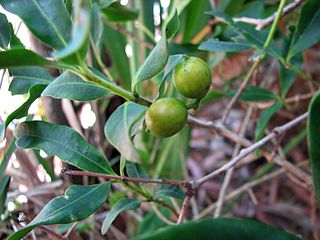
Apocynaceae is a family of flowering plants that includes trees, shrubs, herbs, stem succulents, and vines, commonly known as the dogbane family, because some taxa were used as dog poison. Members of the family are native to the European, Asian, African, Australian, and American tropics or subtropics, with some temperate members. The former family Asclepiadaceae is considered a subfamily of Apocynaceae and contains 348 genera. A list of Apocynaceae genera may be found here.

Alyxia is an Australasian genus of flowering plant in the dogbane family, Apocynaceae. It contains at present 106 species, but Alyxia stellata and A. tisserantii are very variable, might be cryptic species complexes, and are need of further study. It consists of shrubby, climbing or scrambling plants. This genus occurs in China, the Himalayas, Southeast Asia, Malaysia, Australia, New Caledonia and the Pacific Islands. There are 14 species in Australia, 21 in New Caledonia and 7 in the other Pacific Islands, including Hawaiʻi.
Kokia kauaiensis, the Kauai treecotton or Kauaʻi Kokiʻo, is a species of flowering plant in the mallow family, Malvaceae, that is endemic to Kauaʻi, Hawaii.
Alyxia menglungensis is a species of flowering plant in the family Apocynaceae, that is endemic to China.
Alyxia taiwanensis is a species of flowering plant in the family Apocynaceae, that is endemic to Taiwan. It is threatened by habitat loss. It grows orange berries and eye shaped, leather-like leaves. The leaves grow in whorls of 3-7 opposite to each other on long twirling vines. Seeds begin forming in approximately 1 month, germinating in just over 4 months.

Eugenia koolauensis, commonly known as Koʻolau eugenia or nioi, is a species of flowering plant in the myrtle family, Myrtaceae. It is endemic to Hawaii, where it could previously be found on the islands of Molokaʻi and Oʻahu; today populations only exist on the latter. This is a federally listed endangered species of the United States.
Melicope pallida, the pale melicope, is a species of tree in the family Rutaceae. It is endemic to the Hawaiian Islands. It is threatened by habitat loss. It is a federally listed endangered species of the United States. Like other Hawaiian Melicope, this species is known as alani.

Urera kaalae, opuhe, is a species of flowering plant in the nettle family, Urticaceae, that is endemic to the island of Oʻahu in Hawaii. It inhabits slopes and gulches in mesic forests at elevations of 300–Asplenium kaulfusii, Athyrium spp., ʻāwikiwiki, pāpala, ʻakoko, poʻolā, ēlama, Doryopteris spp., ʻieʻi.e., manono, Hibiscus spp., olopua, māmaki, hala pepe, ʻālaʻa, kōpiko, heuhiuhi, aʻiaʻi, ōpuhe, and maua. It is threatened by habitat loss.
Aglycyderini are a tribe of belids, primitive weevils of the family Belidae. Like in other belids, their antennae are straight, not elbowed as in the true weevils (Curculionidae). They occur only on the Pacific Islands and in the Macaronesian region.

Alyxia buxifolia, the sea box or dysentery bush, is a species of shrub in the family Apocynaceae.
Dysentery bush is a common name for several Australian plants and may refer to:

Pleomele is a genus of flowering plants, sometimes placed in the genus Dracaena. In the APG III classification system, both genera are placed in the family Asparagaceae, subfamily Nolinoideae. The Hawaiian name for plants in this genus is hala pepe, which translates to crushed or dwarfed Pandanus tectorius.

Alyxia ruscifolia, commonly known as the chainfruit or prickly alyxia, is a shrub of high rainfall areas in eastern Australia. The natural range of distribution is from Wollongong in New South Wales to the Wet Tropics and further north to New Guinea.

Darna pallivitta, the nettle caterpillar or stinging nettle caterpillar, is a moth of the family Limacodidae. It is native to China, Taiwan, Thailand, Peninsular Malaysia, Java and Borneo. But it is now also established in the Hawaiian islands and Japan.
Schiedea sarmentosa is a rare species of flowering plant in the family Caryophyllaceae known by the common name cliff schiedea. It is endemic to Hawaii, where it is known only from the island of Molokai. It is threatened by the degradation and destruction of its habitat. It is a federally listed endangered species of the United States.

Alyxia spicata, commonly known as chain fruit, is a sprawling shrub or vine in the family Apocynaceae. It is native to New Guinea and the Australian tropics.

Alyxia squamulosa, commonly known as alyxia vine, is a species of shrub in the family Apocynaceae. It is endemic to Australia’s subtropical Lord Howe Island in the Tasman Sea. The specific epithet derives from the many bracteoles, or ‘scales’ that subtend the flowers. The plant previously known as Alyxia lindii is considered a taxonomic synonym of A. squamulosa, being reassigned in 2002.
Alyxia fosbergii is a plant species known only from Henderson Island, one of the Pitcairn Group of Islands in the Pacific Ocean. Henderson Island is an uninhabited raised coral atoll, with an area of 37.3 km2. It has been declared a World Heritage Site by the United Nations.
A. floribunda may refer to:








